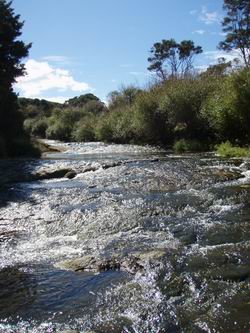Executive Summary
This report provides an update on the current water quality state at the 35 Northland River Water Quality Monitoring Network (RWQMN) sites and trends in water quality at 21 sites. Monitoring at these sites was carried out monthly and examines a range of variables including temperature, water clarity, bacteria and nutrient concentrations. Water quality data was compared to the Australian and New Zealand Environmental and Conservation Council guidelines (ANZECC, 2000) for the protection of aquatic ecosystems, the microbiological water quality guidelines for recreational users (MFE, 2003) and the Regional Water and Soil Plan (NRC, 2007).
 Formal trend analysis was carried out using Time Trends software (NIWA) on sites with more than five years of data. Trend analysis was carried out on data from October 1996 to June 2010 for all sites when available. For sites that have been added to the network after October 1996, trend analysis included data from when sampling began.
Formal trend analysis was carried out using Time Trends software (NIWA) on sites with more than five years of data. Trend analysis was carried out on data from October 1996 to June 2010 for all sites when available. For sites that have been added to the network after October 1996, trend analysis included data from when sampling began.
Analysis of water quality state shows that many of Northland's rivers have poor water quality (as assessed against the guidelines) on occasion, even at sites in more pristine environments such as the Waipoua and Waipapa Rivers. Water quality can be strongly influenced by its surrounding land use. Compliance is generally consistently poor at sites in intensive pastoral farming catchments, which includes the Ruakaka, Paparoa and Awanui at Waihue Channel River sites. These sites generally have low water clarity and higher nutrient concentrations. These results are consistent with other national findings (Ballantine et al, 2010. Ballantine & Davies-Colley, 2009. Larned et al, 2004).
Overall there are several positive changes in water quality detected in the trend analysis for 1996 to 2010. Significant improving trends in dissolved reactive phosphorus and total phosphorus were recorded at 11 and 13 sites, respectively. These trends were recorded across all catchment land use types; native forest, exotic forest, urban and pastoral.
Significant improving trends were also observed in all nitrogen species across nine sites; three of these are significant dairying catchments. Improvements in water clarity were detected at seven sites, with the majority of these located in intensive pastoral farming catchments. Eleven improving trends were recorded in the Mangere catchment, which has a large proportion of dairying in the catchment (40% of the 75% pastoral land). NRC has been actively working alongside dairy farmers in this catchment to minimize the impact of discharges.
